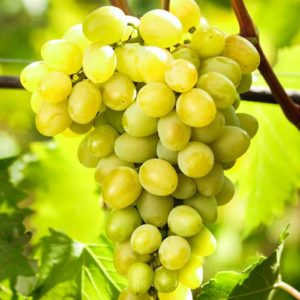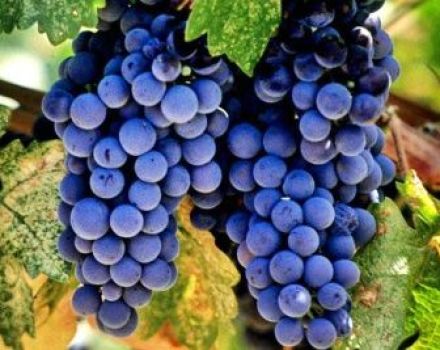Description of varieties and characteristics of Muscat grapes and cultivation features
There is an opinion that grape varieties from the Muscat group should be grown only by winemakers who have the opportunity to organize plantations in warm countries. This is due to the fact that grape crops belonging to this category are quite whimsical. But breeders have long bred varieties that can germinate successfully in a changeable cool climate. For example, in the cities of Central Russia.
Pros and cons of Muscat grapes
Many people have a genuine love for the unusual taste of Muscat grapes. Ripe fruits are very sugary, which is why they have a pronounced sweetness. Muscat has a multifaceted taste and aroma with hints of flowers, caramel, herbs, berries and, of course, musk.
They are suitable for making a variety of wines. This is due to both the diversity of species and the fertility of most of them. With proper care, grapes can "occupy" the entire site and the surrounding area. Accordingly, one of the main advantages is high fertility (on average, it is 50-60 centners of yield per 1 hectare of land).
Muscat contains phytoncides. These are biologically active substances that significantly inhibit the growth of pathogenic and opportunistic microflora in the intestine. It is curious that phytoncides are found not only in grapes, but also in onions, garlic, and pine cones.
The main disadvantage of muscats is their whimsicality. This applies to classic non-hybrid varieties.
Muscat grape crops are warm and light-requiring. They are recommended to be planted in suitable climates and in elevated areas. Therefore, such varieties are common in the Crimean, Moldavian and Georgian vineyards. But this does not mean that all varieties require special conditions. Scientists have developed hybrid varieties that can withstand significant frosts, are resistant to common fungal diseases and gray mold.
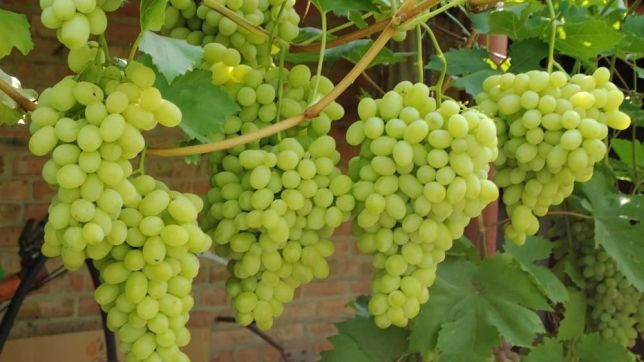
The best varieties of nutmeg grapes - description and characteristics
Some varieties stand out from the rest. These include:
- The black.
- Pink.
- Hamburg.
- Alexandrian.
- Hungarian.
- Frankincense (White).
They are the best known and are used to make the finest wines. There are also many varieties of Frankincense, Black and Rose grapes. They differ in their characteristics.

White superearly
White superearly grape Muscat has the property of increased sugar accumulation.In ripe berries, the sugar content reaches 25-30%, which makes it possible to use this type for the manufacture of sweet dessert wines.
General characteristics of the species:
- unstable to frost, dies at temperatures of -20 ° C and below;
- ripens for about 120 days, preferably planted in early spring;
- not resistant to common fungal diseases;
- average in fertility, from one hectare harvested from 50 centners of the crop;
- berries are small (2-3 grams), like clusters (up to 500 grams);
- place of origin: Egypt or Arabia.

Muscat Shatilova
Shatilov's Muscat is a hybrid white grape variety. This species is notable for the fact that it was created specifically for cultivation in the Russian climate. That is, grapes are resistant to frost and temperature extremes, precipitation. It does not need to be planted in an elevated area. The variety is unpretentious, rarely gets sick and does not require frequent watering. Average fertility.
Type description:
- ripening by the end of August-beginning of September;
- frost resistance above average (up to -30 ˚С);
- medium-sized berry (4-6 grams) and a bunch (up to 1000 grams);
- sugar content - from 16 to 20%;
- place of origin: Russia.
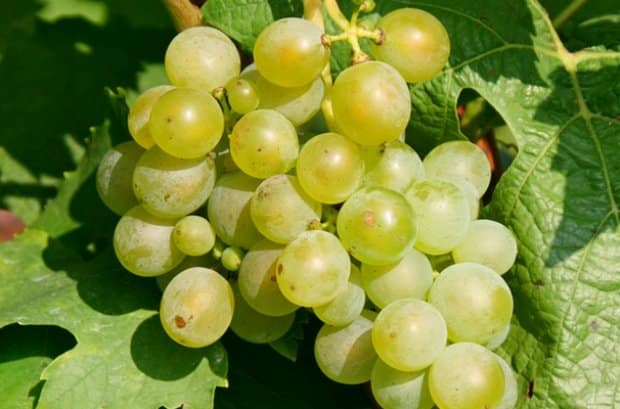
The berries have a yellow-golden hue, light green veins. As a rule, they have a moderately musky odor and a sweet taste.
The black
Black Muscat grapes, according to some sources, originated in the Crimea at the end of the 19th century. It still actively grows on this peninsula, as well as in the south of France. Grown in warm climates, on elevated land surfaces (mainly on slopes). The main name of black nutmeg is Kalyaba or Kayaba. This species is distinguished by an above average yield, the fruitfulness of the shoots is more than 60%.
Description of the variety:
- medium-sized milk mushrooms (up to 1000 grams), like berries (up to 10 grams);
- sugar content - up to 20%;
- low frost resistance, high light-requiring;
- the yield is, on average, 60 centners per hectare;
- ripening takes from 130 to 150 days;
- the species is resistant to fungal diseases, but is susceptible to attacks by leaf rollers;
- ripe berries are dark blue.
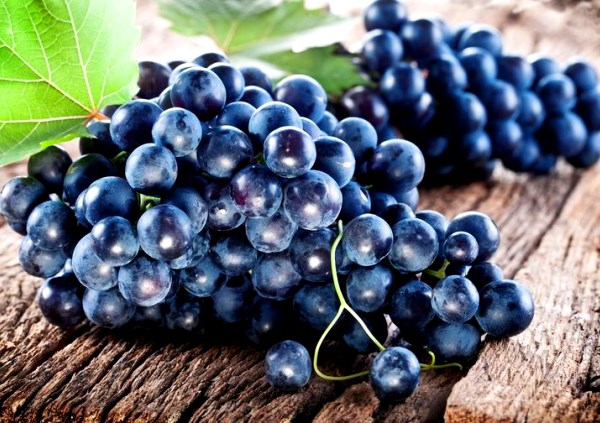
Kalyaba is a sweet nutmeg suitable for making dessert wines.
Hamburg muscat
Hamburg nutmeg is a dark grape variety. It first appeared in England, but is now distributed almost all over the world. This type of nutmeg can be found in Ukraine, Moldova, France, Tunisia, Italy.
Characteristics of Hamburg Muscat grapes:
- thermophilicity (dies at -19 ° C);
- moderate light-requiring (can be planted on a flat surface);
- high susceptibility to diseases, fragile crest;
- the yield is unstable, it can reach 70 centners per hectare, but usually fluctuates between 30-40 centners;
- small fruits (2-4 grams), small clusters (200-350 grams);
- the shade of berries is blue-violet, dark;
- sugar content - up to 22%.
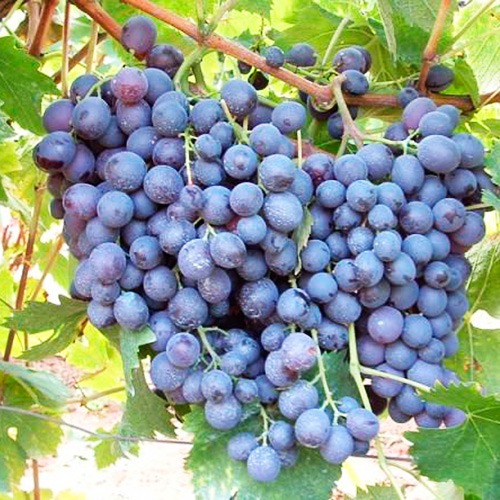
The value of this grape lies in the fact that it produces quality wine with the right taste and aroma.
Famine
Classic Golodrigi is a versatile Muscat grape named after a Ukrainian scientist and breeder with a corresponding surname. It was he who bred this variety, crossing Magarach and Korolev. Holodrigi are highly resistant to drought and frost, fungal diseases and viruses. This grape belongs to high-yielding grapes (from 1 hectare you can harvest up to 150 centners). It is problem-free, medium ripening (120-135 days) and suitable for growing in variable climates.
Characteristics of the variety:
- sugar content - up to 23%;
- frost resistance - up to -24 ° C;
- the average weight of a load is 300 grams, one berry is 2-3 grams.

There are several varieties of this grape, among which the most sugary is the Memory of Golodriga variety. It contains 29% sugar.
Blau
The Blau grape is a noble nutmeg that originated in Switzerland.This type is used to make classic red wines with a pronounced musky aroma. In general, Blau is unpretentious, resistant to frost (down to -27 ° C) and fungal diseases. Moreover, it is often attacked by flying insects, in particular wasps. You can plant this variety anywhere, not necessarily on a slope or other hill. Blau requires careful maintenance, watering and handling.
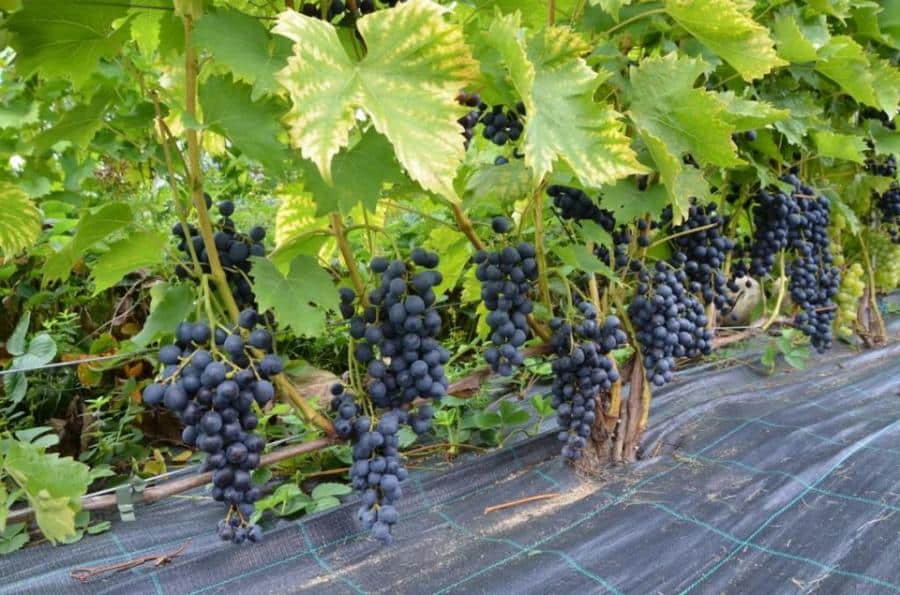
The berries have a rich dark blue hue, weigh, on average, 5-6 grams. The whole bunch usually does not exceed 500 grams in weight. Ripening of this nutmeg lasts from 120 to 130 days.
Muscat grapes by category
Some are interested in the most unpretentious varieties of muscat, while others are interested in the most suitable for winemaking. In order to choose the best option for a particular case, you need to familiarize yourself with the representatives of each category.
Fast maturing
The fastest ripening varieties include the following:
- Muscat Amber - grapes ripen in 110-120 days. Low resistance to frost (dies at -20 ° C) and fungal diseases. The bunches are small (200-250 grams), the berries are medium (2-3 grams). High-yielding - 80-90 centners of the crop per hectare of land. The species is intended for cultivation in the Central Asian regions.
- Donskoy - ripens in 115-125 days. It is highly resistant to frost (down to -28 ° C). Donskoy Muscat is a grape with a pronounced nutmeg taste and smell. The bunches are small (up to 300 grams), like the berries. The yield is average, one plant accounts for about 50% of fruiting shoots. The grapes are resistant to fungal diseases.
- Early Red Muscat - grapes that ripen in 95-100 days. It can usually be harvested as early as July. This variety is resistant to frost down to -26 ° C and to gray mold. The yield is high (80-90 centners per hectare). Bunches weigh up to 350 grams, individual berries - 2-4 grams.
- Summer - ripens in 100-120 days. Differs in large berries (8-9 grams) and bunches (up to 1000 grams). It has an interesting herbaceous taste and a weak musk smell. Grape variety Summer Muscat is unpretentious, resistant to frost down to -25 ° C, as well as to diseases and pests.
- Muscat Moscow - ripens in 100-115 days. Not resistant to frost, mildew and powdery mildew. The yield is high, reaching 100 centners per hectare. The sugar content in Moscow Muscat grapes is slightly above average (about 17%). One berry weighs 4 grams, a bunch - about 500 grams.
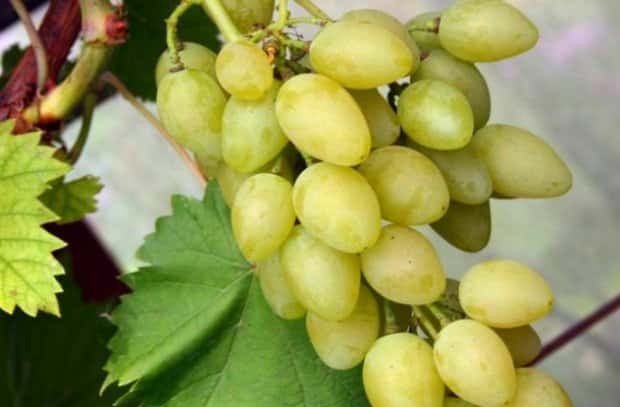
Highly resistant to cold and disease
They are resistant to cold, pests and fungal diseases and are ideal for growing in Russian cities. They are usually unpretentious and do not require special care.
These varieties include:
- Odessa Muscat grapes - resistant to frost down to -27 ° C, mildew and powdery mildew. Sugar content is, on average, 20%. Ripening takes from 130 to 150 days. The yield is average. A bunch of Moscow nutmeg weighs approximately 300-400 grams, one berry weighs 2-3 grams.
- Pridonskiy Muscat - resistant to frost down to -30 ° C, mildew, mildew and gray mold. Sugar content is high (about 25%). Ripening is medium late, takes from 130 to 140 days. The yield of grapes Pridonsky Muscat is below average, usually it is possible to collect no more than 30-40 centners per hectare of land. Bunches are small, weighing 200-300 grams, berries - 2.5 grams.
- Muscat de Codru - resistant to frost down to -29 ° C and to the most common fungal diseases. Sugar content - up to 18%. High yield (up to 90% of fruitful shoots per bush). Medium-sized clusters weighing up to 800 grams. The berries weigh 7-8 grams.
- Muscat of Alexandria - resistant to frost down to -28 ° C, mildew and powdery mildew. Sugar content to varies from 15 to 30%. The yield also varies greatly from case to case, but can reach 110 centners per 1 hectare (on average, 70-80 centners). The bunches and berries are small.
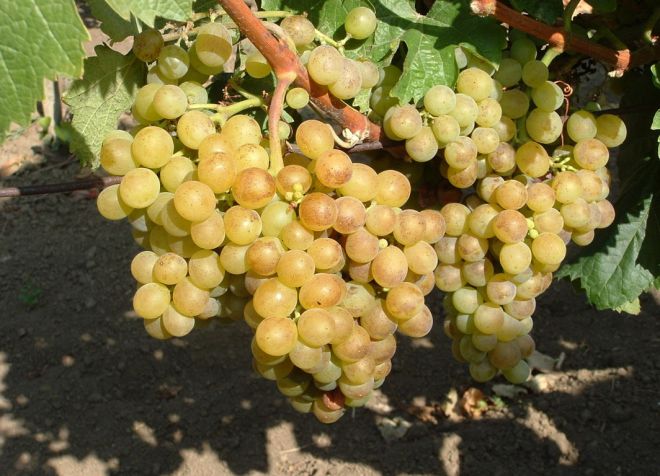
The most prolific varieties
The most prolific Muscat is the early Pink grape. The number of fruiting shoots in this species ranges from 85 to 95%. Moreover, the period of full maturation takes from 95 to 100 days. These grapes are not resistant to frost and are often "sick", so they must be carefully looked after.
New hybrid varieties such as Lyubimy and Noble Muscat are also highly fertile.
Both of them consistently bring 80-90 centners of the crop per hectare of land. At the same time, hybrid varieties practically do not get sick, they tolerate cold well. Muscat Noble "survives" temperatures down to -26 ° C, and Favorite - up to -24 ° C.
Landing features
It is advisable to plant almost all muscat in elevated areas, slopes, so that they are constantly under the rays of the sun. So the grapes accumulate more sugar, ripen faster and give a good harvest.
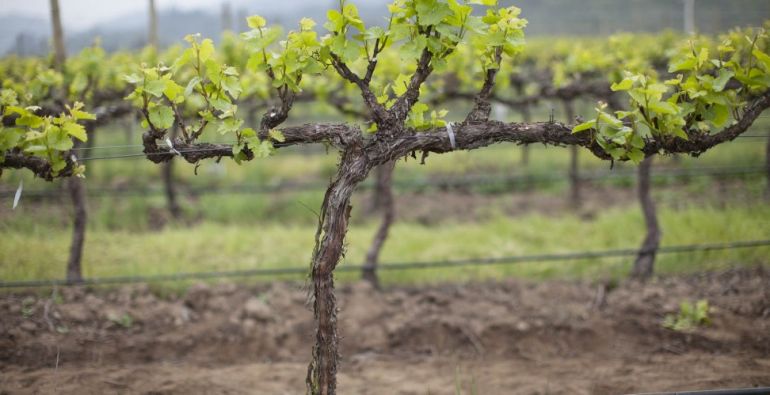
For each seedling, you need to dig a separate hole about 80-100 centimeters deep and wide. When planting cuttings in one row, you need to calculate the distance between them, it should be at least 1 meter, preferably 1.5. It is also imperative to install a peg-shaped support under each hole.
In the hole itself, you need to make a small mound of soil, and then place a seedling on it, after having straightened the roots of the plant.
Next, you should sprinkle everything with earth, and tie the grapes to a peg. Before planting, you can drain the soil by placing rubble in it to a depth of no more than 10-15 centimeters. This is done if the land is waterlogged. When planting grapes in the cold season, you should immediately add mulch to the soil surface. It is also advisable to fertilize the land with humus or peat.

Growing and grooming tips
In order to properly grow Muscat grapes, you need to take into account these recommendations:
- For the winter, almost all nutmegs need to be covered, even if they are reasonably frost-resistant. Especially if the plants are grown in cold regions with harsh winters. At temperatures below -25 ° C, many nutmegs begin to die.
- For a full-fledged plantation occupying a large area, a drip irrigation and soil spraying system is required. It needs to be "activated" during the active growth of grapes. As soon as the berries begin to ripen, the number and volume of watering must be reduced, otherwise the crop will be watery and unsweetened.
- Muscats need to be processed every year, preferably in early spring or fall. For treatment, you can use Quadris, Paracelsus, Sirocco or other agents belonging to the group of insecticides / fungicides. These drugs are used to control diseases and pests. Insecticides are designed to kill insects, fungicides - to prevent fungal diseases.
In order to provide ideal conditions for the grapes, you need to use a trellis - a special design that provides good support for the plant.
You should also periodically (every 2-4 weeks) loosen the soil between the rows and near the roots of the seedlings, while not touching the plant itself.

